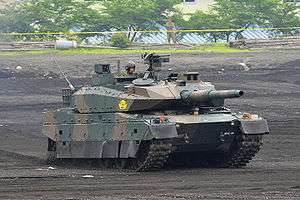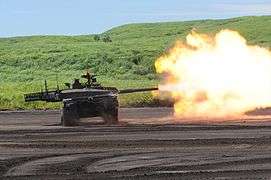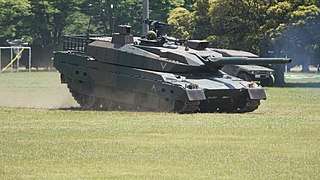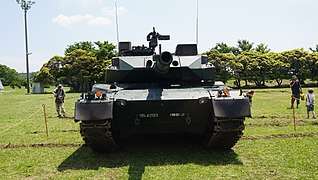Type 10
The Type 10 (10式戦車, Hitomaru-shiki sensha) is a next generation main battle tank of JSDF produced by Mitsubishi Heavy Industries for the Japanese Ground Self Defense Force. Compared with other currently-serving main battle tanks in the JGSDF, the Type 10 has been equipped with enhancements in its capability to respond to anti-tank warfare and other contingencies.[2]
| Type 10 | |
|---|---|
 A JGSDF Type 10 Tank in 2015 | |
| Type | Main battle tank |
| Place of origin | Japan |
| Service history | |
| In service | 2012–present |
| Production history | |
| Manufacturer | Mitsubishi Heavy Industries |
| Unit cost | $8.4 million (2014) |
| Produced | 2010 (in production) |
| No. built | 103 (FY 2010–2016) |
| Specifications | |
| Mass | 40 tonnes (basic loadout), 44 tonnes (standard loadout), 48 tonnes (full loadout) |
| Length | 9.485 m |
| Width | 3.24 m |
| Height | 2.30 m |
| Crew | 3 (commander, gunner and driver) |
| Armor | Nano-crystal steel, modular ceramic composite armor, light-weight upper armor. |
Main armament | Japan Steel Works 120 mm smoothbore cannon with automatic loader (36 rounds) |
Secondary armament | M2HB 12.7 mm machine gun Type 74 7.62 mm machine gun |
| Engine | 4-stroke V8 diesel 22.6 litre 1,200 hp/2,300 rpm |
| Power/weight | 27 hp/tonne |
| Transmission | Continuously variable transmission (Hydraulic Mechanical Transmission) |
| Suspension | Hydropneumatic Active suspension |
Operational range | 500 km |
| Maximum speed | Forward: 70 km/h Backward: 70 km/h[1] |
Overview
The TK-X (MBT-X) project aimed to produce the new Type 10 main battle tank, to replace or complement the existing Type 74 and Type 90 main battle tanks that are currently in service with the Japan Ground Self Defense Force. Development began in the 1990s, and production was expected to start in 2010–2011. A prototype was revealed on February 13, 2008 at the Technology Research and Development Institute (TRDI) in Sagamihara. Heavy emphasis was placed on C4I capabilities as well as on performance, firepower, protection and mobility.[3]
Design
Development history
In the early 2000s, Japan decided to update its tank force to better prepare for 21st Century warfare. One of the most important requirements for the new tank is the capability of having a C4I (Command, Control, Communication and Computing) system. After assessing the upgrade potential of current Type 74 and Type 90 main battle tanks, the Ministry of Defence concluded that there was not enough internal space for a C4I system upgrade on existing tanks. Therefore, the development of a new main battle tank capable of various future battle missions was necessary.[4]
Armor
The use of modular components significantly improved the side armor compared to the Type 90. The Commander's Panoramic Sight was moved to the right and is located at a higher position than the Type 90, giving the commander a wide range of view.
The vehicle's armor consists of modular sections, providing the ability to mount varying degrees of protection depending on the mission profile and weight requirements. Vehicle weight is 40 tonnes in base configuration, 44 tonnes in standard configuration, and 48 tonnes in full configuration (fully equipped). The prototype featured in 2008 at TRDI weighed 44 tonnes.[5]
Armament
Whereas the Type 90 used the same 120mm Rheinmetall main gun as other Western powers, the Type 10 uses a completely new gun, developed indigenously by Japan Steel Works.[6] There is an option for longer barrels of 50 and 55 calibers (L50, L55). The Type 10's new cannon can fire the normal JM33 APFSDS (license produced DM33 shell acquired from Germany) as well as all standard 120 mm NATO ammunition. One major improvement over the earlier Rheinmetall L44 cannon is that this new JSW gun mounted on the Type 10 tank can also fire an improved round, the newly developed Type 10 APFSDS round, which is specifically designed for and can only be fired by the Type 10.[7]
Electronics
The Type 10 tank is equipped with C4I system (Command, Control, Communication, Computer & Intelligence). This can be incorporated into the JGSDF network to enable sharing of information among tanks, as well as connected to the infantry's outdoor computer network "Regiment Command Control System" (ReCS) to facilitate integrated military operations with the infantry troops.[2] Other features are as follows:
- Continuously Variable Transmission (CVT)[8] that allows the tank to reach 70 km/h forward as well as reverse.
- Autoloader with crew of three (Commander and gunner in the turret, driver in the hull).
- Hydropneumatic active suspension,[8] which allows it to adjust its stance and absorbs recoil when firing.
- Day/night sights mounted around the turret, providing a full 360° coverage as well as providing input to the C4I system.[5]
Strategic transportation
The predecessor of Type 10, the Type 90 main battle tank, was deployed only in Hokkaido due to the weight limit of roads and bridges in other parts of Japan. One of the primary purposes of Type 10 is to be able to deploy anywhere in Japan. Size and weight reductions have made Type 10 now six metric tonnes lighter than Type 90, weighing only 44 tonnes. 84% of Japan's 17920 bridges are passable for the Type 10, compared to only 65% of passability of Type 90 and 40% of mainstream western main battle tanks.[9]
Development
The development costs as of 2008 are approximately JPY ¥48,400M (approximately USD $450M). Each unit is expected to cost approximately ¥700M ($6.5M).[5]
The Japanese Ministry of Defense formally acknowledged the Type 10 in December 2009. In 2010, the Japanese Ministry of Defense placed a ¥12,400M order for thirteen Type 10 tanks (Unit cost: ¥954M).[10]
These Type 10 tanks entered JGSDF service in January, 2012.[11]
Export
On 4 January 2014, sources revealed that Turkey was interested in signing a joint development deal of tank engines based on the Type 10's engine. The Type 10 tank boasts of high mobility, including a backward movement speed of 70 km/h (43 mph).[12] The engine was to power the Turkish Altay indigenous tank. However, negotiations broke down and the deal was "off the agenda" by March 2014. Reasons included Japan's stringent arms export ban laws, the intention of Turkey to attempt to export the Altay, and Japan's reluctance to license the joint engine.[13]
Operators

Gallery
 Prototype #3
Prototype #3- Prototype #3 rear
- Production model
 Shooting of 120 mm Smoothbore gun
Shooting of 120 mm Smoothbore gun .50 caliber M2 Gun and smoke discharger
.50 caliber M2 Gun and smoke discharger- Sensors and .50 caliber M2 Gun

- Type 90 (left) and Type 10
- Type 74 (left) and Type 10
 JGSDF Type 10 tank brakes during demonstration exercise
JGSDF Type 10 tank brakes during demonstration exercise JGSDF Type 10 tank front view
JGSDF Type 10 tank front view
Notes
- 10式戦車 走行展示 Type10 Tank, Japan's new MBT. YouTube. 11 July 2010. Archived from the original on 9 April 2016. Retrieved 3 April 2015.
- Introduction of the aircraft Type 10 tank -Japanese Ministry of Defense, Japan Defense Focus No.33 Column, Oct 2012
http://www.mod.go.jp/e/jdf/no33/column.html Archived 2013-01-27 at the Wayback Machine - Japanese Ministry of Defense Technology Research and Development Institute (TRDI)"Archived copy". Archived from the original on 2010-09-01. Retrieved 2010-05-10.CS1 maint: archived copy as title (link)
- 戦車研究室 10式戦車の開発経緯
http://combat1.sakura.ne.jp/10SHIKI.htm Archived 2017-01-16 at the Wayback Machine - Type 10 MBT-X Prototype (TK-X). GlobalSecurity.org
http://www.globalsecurity.org/military/world/japan/mbt-x.htm Archived 2018-12-12 at the Wayback Machine - "Type 10 Tank of Japan Ground Self Defense Force". Global Military Review. Archived from the original on 27 September 2015. Retrieved 3 April 2015.
- "Japanese MOF report" (PDF). Archived (PDF) from the original on 2013-02-03. Retrieved 2015-03-06.
- "Accelerating Defence Acquisition: What Defence Can Learn From the World of Motorsport" RUSI Defence Systems, June 2008, pp. 81–82
"Archived copy" (PDF). Archived from the original (PDF) on 2008-11-20. Retrieved 2009-02-05.CS1 maint: archived copy as title (link) - "新たな時代の安全保障と防衛力に関する懇談会 - 第5回配布資料 「防衛生産・技術基盤」平成22年(2010年)4月(防衛省)" (PDF). Archived (PDF) from the original on 2016-03-04. Retrieved 2017-01-15.
- "Based on the production of thirteen Type 10 tanks during FY2010" (PDF). Archived (PDF) from the original on 2011-03-23. Retrieved 2010-06-05.
- "時事ドットコム:動画特集 陸上自衛隊「10式戦車」入魂式=量産型1号車に機甲の魂を注入". 時事ドットコム. Archived from the original on 3 April 2015. Retrieved 3 April 2015.
- Japan is looking to develop an engine for main battle tank in collaboration with Turkey Archived 2014-01-07 at the Wayback Machine – Armyrecognition.com, 7 January 2014
- Japan Deal Scrapped, Turkey Looking for Tank Engine – Defensenews.com, 5 March 2014
References
- Type 10 MBT-X Prototype (TK-X). GlobalSecurity.org
- Shinichi Kiyotani, 'Japan unveils TK-X main battle tank prototype,' Jane's Defence Weekly, Vol.45, Issue 9, 27 February 2008, p. 13
- Japan unveils MBT prototype – Jane's Land Forces News.
- Accelerating Defence Acquisition: What Defence Can Learn From the World of Motorsport – Royal United Services Institute for Defence and Security Studies(RUSI), 'RUSI Defence Systems, June 2008, pp. 81–82'.
- IDG News Service video on the Type 10 tank
- Development report of JSDF New tank (Japanese) 1 – Japanese Ministry of Defense.
- Development report of JSDF New tank (Japanese) 2 – Japanese Ministry of Defense.
- Development report of JSDF New tank (Japanese) 3 – Japanese Ministry of Defense.
- Introduction of the aircraft Type 10 tank: Japan Defense Focus No.33 Column, Oct 2012 – Japanese Ministry of Defense.
- New Tank – Japanese Ministry of Defense TRDI.
- TRDI 50th Annual – Japanese Ministry of Defense TRDI.
External links
| Wikimedia Commons has media related to JGSDF Type 10 tanks. |